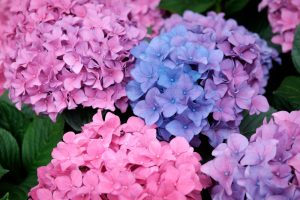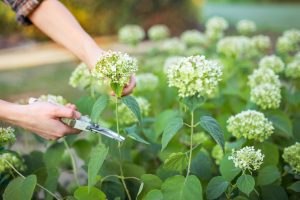Garden Care: the Best Tips for Hydrangeas

Taking care of hydrangeas is no different from looking after any other plant. Though there are some specific things to keep in mind, they’re all quite simple.
These tips will help keep your garden beautiful and well-kept.
Plants, especially the flowering varieties, give off vibrancy, color and warmth to in any space in our home. However, an outdoor garden is also lovely and can cheer up any plant-lover.
In addition, a garden makes for a tranquil area where you can enjoy leisure time, a good book or the company of friends and family.
In today’s post, we’ll talk about the ways to care for this plant. You’ll see that these tips are easy and we’ll tell you what to consider if you’re planning on growing them in your garden.
What are hydrangeas?
The botanic world is huge. There’s an incredible range of plant species out there and it’s easy to confuse which is which.
Hydrangeas, despite popular belief, originate from Asia and are actually a deciduous bush and not a flower. There are around 43 recognized kinds of hydrangeas.
The flowers grow in beautiful bunches. Hydrangeas come in a wide range of colors. In addition, they give off a unique and inciting fragrance.
Curiously, the colors of a hydrangea plant don’t depend on the species but rather, the kinds of nutrients that the plant absorbs. We’ll explain this in more detail later on in the post.

Additionally, people most often place these plants outdoors in patios or gardens. However, they’re perfect indoor plants as well.
Taking care of hydrangeas
As with any kind of plant, these also have specific needs.
However, they’re far from complicated. Understanding these needs will be a huge help if we want to plant hydrangeas in our garden.
Water
One of the main care points for hydrangeas that we need to know is proper watering.
They require a lot of water. Thus, you need to water them daily to keep their soil nice and moist.
Sunlight
To take care of hydrangeas properly, you really should know that though this plant needs sunlight, it also needs shade.
Therefore, you should plant it in an area that receives sunlight in the morning and shade in the the afternoon.
Soil
When it comes to soil, hydrangeas can be high-maintenance as they can’t thrive on just any kind of soil.
They’ll grow to be beautiful and strong on acidic soil and wither if planted otherwise. So, organic compost is crucial in addition to liquid fertilizer every 15 days for strong plants.

A fun tip: if you want piercing blue hydrangeas, place some metal nails, a piece of aluminum and fruit peel onto the soil bed. The plant will absorb the minerals in these elements and turn blue.
The color of a hydrangea plant, as we mentioned earlier, isn’t linked to its species but rather, the nutrients that it absorbs.
Diseases and insects
Another care point for hydrangeas is detecting and preventing diseases and insects that could harm them.
Aphids and red spider mites are two of the more common insects that attack hydrangeas.
In addition, fungus can also be a frequent problem with these plants, which causes them to rot.
In order to fight back against these threats, you can try using pesticides or natural remedies.
Pruning
For hydrangeas that grow healthily and produce more and more flowers each year, you need to prune them.
Pruning consists of cutting off wilted flowers and stems.
Pruning should take place after the plant flowers.
Doing this will prevent the plant from dying and will ensure a healthy, flowering plant each year for our garden.

As you’ve read, taking care of hydrangeas is quite simple. With a little information and experience, we can enjoy our beautiful hydrangeas in the garden.
We have one last tip for you. In the extreme cold or poor weather conditions, cover them with a box if you can’t move them indoors.
Taking care of hydrangeas is no different from looking after any other plant. Though there are some specific things to keep in mind, they’re all quite simple.
These tips will help keep your garden beautiful and well-kept.
Plants, especially the flowering varieties, give off vibrancy, color and warmth to in any space in our home. However, an outdoor garden is also lovely and can cheer up any plant-lover.
In addition, a garden makes for a tranquil area where you can enjoy leisure time, a good book or the company of friends and family.
In today’s post, we’ll talk about the ways to care for this plant. You’ll see that these tips are easy and we’ll tell you what to consider if you’re planning on growing them in your garden.
What are hydrangeas?
The botanic world is huge. There’s an incredible range of plant species out there and it’s easy to confuse which is which.
Hydrangeas, despite popular belief, originate from Asia and are actually a deciduous bush and not a flower. There are around 43 recognized kinds of hydrangeas.
The flowers grow in beautiful bunches. Hydrangeas come in a wide range of colors. In addition, they give off a unique and inciting fragrance.
Curiously, the colors of a hydrangea plant don’t depend on the species but rather, the kinds of nutrients that the plant absorbs. We’ll explain this in more detail later on in the post.

Additionally, people most often place these plants outdoors in patios or gardens. However, they’re perfect indoor plants as well.
Taking care of hydrangeas
As with any kind of plant, these also have specific needs.
However, they’re far from complicated. Understanding these needs will be a huge help if we want to plant hydrangeas in our garden.
Water
One of the main care points for hydrangeas that we need to know is proper watering.
They require a lot of water. Thus, you need to water them daily to keep their soil nice and moist.
Sunlight
To take care of hydrangeas properly, you really should know that though this plant needs sunlight, it also needs shade.
Therefore, you should plant it in an area that receives sunlight in the morning and shade in the the afternoon.
Soil
When it comes to soil, hydrangeas can be high-maintenance as they can’t thrive on just any kind of soil.
They’ll grow to be beautiful and strong on acidic soil and wither if planted otherwise. So, organic compost is crucial in addition to liquid fertilizer every 15 days for strong plants.

A fun tip: if you want piercing blue hydrangeas, place some metal nails, a piece of aluminum and fruit peel onto the soil bed. The plant will absorb the minerals in these elements and turn blue.
The color of a hydrangea plant, as we mentioned earlier, isn’t linked to its species but rather, the nutrients that it absorbs.
Diseases and insects
Another care point for hydrangeas is detecting and preventing diseases and insects that could harm them.
Aphids and red spider mites are two of the more common insects that attack hydrangeas.
In addition, fungus can also be a frequent problem with these plants, which causes them to rot.
In order to fight back against these threats, you can try using pesticides or natural remedies.
Pruning
For hydrangeas that grow healthily and produce more and more flowers each year, you need to prune them.
Pruning consists of cutting off wilted flowers and stems.
Pruning should take place after the plant flowers.
Doing this will prevent the plant from dying and will ensure a healthy, flowering plant each year for our garden.

As you’ve read, taking care of hydrangeas is quite simple. With a little information and experience, we can enjoy our beautiful hydrangeas in the garden.
We have one last tip for you. In the extreme cold or poor weather conditions, cover them with a box if you can’t move them indoors.







